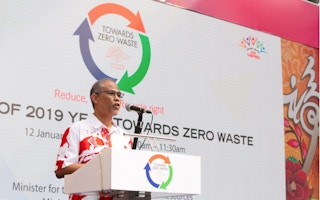A few Saturdays ago, in a shopping mall in the east of the island, Singapore’s Minister of Environment and Water Resources (MEWR) declared 2019 the Year Towards Zero Waste.
To continue reading, subscribe to Eco‑Business.
There's something for everyone. We offer a range of subscription plans.
- Access our stories and receive our Insights Weekly newsletter with the free EB Member plan.
- Unlock unlimited access to our content and archive with EB Circle.
- Publish your content with EB Premium.
The aim for the year ahead is to raise awareness of the tiny country’s massive waste problem, and to, as Minister Masagos Zulkifli told his audience of Saturday shoppers at Our Tampines Hub, take a “circular” approach to managing a consumer-driven economy that uses more resources per person than any country in Asia Pacific.
A story in national newspaper The Straits Times quoted the minister’s ambition for Singapore to turn “trash into treasure” by reusing and recycling resources, and cited various examples of how local firms were, for example, using discarded fruit peels to make detergent and creating jobs in the process.
But the story, though headlined Singapore needs to relook way it uses resources if it’s to become a zero-waste nation, ignored the elephant in the room: Singapore’s waste strategy has so far been built on burning its waste, not reusing it.
Singapore reuses barely any of its waste.
Of the 800 million kilograms of plastic waste generated last year, 94 per cent was incinerated. Of the 60,000 tonnes of e-waste generated last year, just 6 per cent was recycled. The rest was similarly burnt.
The arguments for incineration are strong in a country so small it is barely visible on a map. The island has only one landfill site, Semakau Island, which will be full in 16 years or less. And better to burn trash than let it leak into the ocean, which Singapore’s neighbours do, right?
But a country that burns almost all of its waste cannot claim to be a zero waste nation.
“
If you make a big investment in incinerators, you won’t want to ban the fuel that feeds them.
Lea Guerrero, regional climate and clean energy campaigner, Global Alliance for Incinerator Alternatives
Turning waste into electricity, a by-product of Singapore’s four incineration plants—another S$3 billion facility, the biggest yet, is to go live this year—is not a truly circular approach.
Physical waste is broken down into toxic fumes, which become toxic ash, and this is buried in a man-made island, which was recently featured in a viral video by a famous video blogger Nuseir Yassin.
In the process, electricity is generated—enough to power, in the case of the new plant, 300,000 four bedroom flats. But more than the energy used to make the materials in the first place?
Burning waste—much of it plastic, but most of it food—puts the circular economy into reverse.
Incinerators rely on the high calorific value of plastic to burn trash more efficiently, which creates an incentive for more plastic to be burned.
This is probably why Singapore has been reluctant to introduce any laws that reduce plastic consumption.
Lea Guerrero, regional climate and clean energy campaigner for the Global Alliance for Incinerator Alternatives (GAIA), tells Eco-Business: “The reason the government is moving softly [on legislation on plastic] is that they’ve invested so heavily in incinerators.”
”If you make a big investment in incinerators, you won’t want to ban the fuel that feeds them,” she says.
Now that another incinerator is being built, “they will need to fuel it,” says Guerrero. “That’s a major block for the government for reducing plastic use.”
Then there’s the impact of incineration on behaviour.
Most Singapore residents, as a video produced by Eco-Business recently showed, do not believe that what they throw in the blue recycling bins beneath their high-rise apartments gets recycled.
People suspect that it will be dumped in with regular waste and burned, which is probably why Singapore residents suck at recycling (40 per cent of the stuff put in recycling bins can’t be recycled).
People typically throw items contaminated with food into the recycling bins. Out of sight, out of mind. But that’s the dangerous thing about incineration. It doesn’t magic waste away. It merely changes it into a different form.
Big incineration plants produce greenhouse gases on a par with a coal-fired power plant, and emit more pollution per unit of energy produced than burning coal.
Air quality readings taken by Eco-Business near an incineration plant in Tuas last year showed high levels of carbon dioxide.
Incineration plants also produce pollutants more toxic than the plastic waste they supposedly make disappear. This is why about half of the cost of an incineration plant goes into pollution control.
The most dangerous pollutant is dioxin, a powerful carcinogen.
The National Environnent Agency (NEA) says that the incinerator’s chimneys remove dioxin and other pollutants before they’re released into the atmosphere.
There is no publicly-available data to prove this is the case, although our readings around the incinerator did not find particularly high measures of PM2.5, which would indicate dioxin in the air.
There is no data either, for the incidences of cancer and other air pollution-related diseases in patients living near the plant. This would make for an interesting study.
How to fix it
How can Singapore reduce its massive waste burden, which has risen forty-fold since the 1970s?
Public education campaigns have been rolled out, but they haven’t worked.
There is no regulation to phase out single-use plastic, and no segregation at source—which is critical for any recycling system to work.
The only regulation of sorts is the Singapore Packaging Agreement, introduced a decade ago. This will require all producers of plastic to declare how much they produce, and how they plan to reduce it—but not until 2020.
There’s no sign yet of an Extended Producer Responsibility (EPR) law which make plastic producers take responsibility for what they put into the market, by collecting and recycling it.
EPR will be introduced for e-waste (in 2021), but not plastic.
What does a real zero waste city look like?
It’s not often that Singapore takes urban planning lessons from the Philippines. But there are lessons to learn from a poor country that struggles with waste overload, a lack of infrastructure and is one of the world’s worst plastic polluters.
In 2014, the Philippines introduced a law that mandates solid waste segregation, collection and distribution to materials recovery facilities (MRF) at a local level.
The best example is the small city of San Fernando, where informal waste pickers have been brought into the formal waste management system, and collect, separate and send waste to MRFs for recycling.
With help from a ban on plastic bags, the city has reduced the amount of waste sent to landfil by 78 per cent, which is on a par with the United States’ waste reduction champion San Francisco.
“It’s about addressing the problem at source,” says Guerrero.
At the moment, as Semakau fills up, Singapore is scrambling for solutions at the end of the pipe, and passing a growing problem on to the next generation, she says.
“It’s not sustainable. Singapore can’t keep building incinerators. If the focus is at the end of the value chain, you will be stuck in a vicious cycle.”
The politics of plastic
MEWR will be publishing a Zero Waste Masterplan in the second half of this year, and is looking for ideas from the public.
Here’s one: build recycling plants, not incinerators.
At the moment, the economics of recycling don’t seem to add up for Singapore. There doesn’t seem to be enough uncontaminated recyclable material for the government to justify building recycling plants, suggests Hailin Pek, director of civic society group Zero Waste SG.
That could change with legislation—a ban or tax on items that are hard to recycle to reduce waste, followed up with a strong campaign—MEWR’s planned #RecycleRight campaign could be just the ticket—to teach residents what they can and cannot recycle.
However, It was suggested by a speaker at a waste management event last week that the government would not introduce any laws to reduce plastic demand before an election.
Convenience-minded Singaporeans, who use plastic bags to dispose of their waste, would vote for the opposition in protest, suggested Nicholas Ng, founder of FoodBank Singapore, an anti-food waste NGO.
But a ban or tax on single-use plastic could work politically if its benefits of reduction were well sold, in combination with the advantages of building a proper recycling ecosystem.
Singapore has the capital, the technology and the know-how to be a regional leader in the circular economy. Singapore consumed 50 million bottles made from Polyethylene terephthalate (PET), the most recyclable type of plastic, last year. What if these bottles were recycled and not burnt, creating the green jobs Minister Masagos was talking about in the process?
That would win politically and help Singapore on its journey to become a real zero waste nation.


















